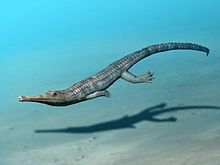Macrospondylus
| Macrospondylus | |
|---|---|

| |
| Macrospondylus bollensis, Holzmaden Germany | |
| Scientific classification | |
| Domain: | Eukaryota |
| Kingdom: | Animalia |
| Phylum: | Chordata |
| Class: | Reptilia |
| Clade: | Archosauria |
| Clade: | Pseudosuchia |
| Clade: | Crocodylomorpha |
| Clade: | Crocodyliformes |
| Suborder: | †Thalattosuchia |
| Superfamily: | †Teleosauroidea |
| Family: | †Machimosauridae |
| Genus: | †Macrospondylus von Meyer, 1831 |
| Species: | †M. bollensis
|
| Binomial name | |
| †Macrospondylus bollensis Jäger, 1828
| |
| Synonyms | |
| |
Macrospondylus is an
crocodyliform from the Early Jurassic (Toarcian) of Europe. Fossils are known from the Posidonia Shale of Germany, the Whitby Mudstone of the United Kingdom, and the "schistes bitumineux
" of Luxembourg.
Evolutionary relationships

Macrospondylus has historically been synonymized with phylogenetic analysis of Thalattosuchia, however, did not support the monophyly of Steneosaurus, as the genera Machimosaurus and Teleosaurus both fell within Steneosaurus.[2] Reinforcing the paraphyly of Steneosaurus, Young et al. (2012), Ősi et al. (2018), and Wilberg et al. (2019) recovered Steneosaurus bollensis and other Steneosaurus species in disparate positions within Teleosauridae.[3][4][5]
In 2016, its length was estimated at 5.5 m (18 ft), making it the largest known Early Jurassic crocodylomorph.[6] In 2020, the genus was formally revived.[7]
See also
References
- ^ Steel R. 1973. Crocodylia. Handbuch der Paläoherpetologie, Teil 16. Stuttgart: Gustav Fischer Verlag,116 pp.
- ^ Mueller-Töwe, I. J. (2005). "Phylogenetic relationships of the Thalattosuchia" (PDF). Zitteliana. A45: 211–213.
- PMID 23028723. edit
- ^ Ősi A, Young MT, Galácz A, Rabi M. 2018. A new large-bodied thalattosuchian crocodyliform from the Lower Jurassic (Toarcian) of Hungary, with further evidence of the mosaic acquisition of marine adaptations in Metriorhynchoidea. PeerJ 6:e4668 https://doi.org/10.7717/peerj.4668
- PMID 30679529.
- doi:10.26879/648.
- PMID 33083104.
